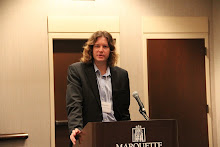I was recently accused, in a very kind manner, of confusing the ontic and ontological levels of Heidegger's perspective when I relate Ereignis to the "opening up of a world" which Heidegger claims art can bring about in the Origin of the Work of Art. I tend to take the most extreme versions of what it would be for art to open a world to be cases in which an originary event in the form of art brings into existence entirely new disclosive practices. The counter claim was that what Heidegger discusses in the Origin of the Work of Art is ontic world change while Ereignis is ontological. This would ground the idea, which I disagree with, that speaking of "originary events" on the scale of Ereignis in the plural is a mistake.
How should we conceive of the ontic-ontological distinction? For those educated in a Kant dominated philosophical context the tendency is certainly to think of it in terms of the empirical-transcendental distinction. I feel, however, that we would be much closer to Heidegger's own thoughts on the issue if we focus instead upon Emil Lask's matter-form distinction. Recognizing the difference between these two models is useful because the Kantian distinction is absolute. Transcendental structures always remain transcendental, and according to most readings of Kant they are not open to change because of events on the empirical level. Lask's matter-form distinction, however, is not absolute. What is formal on one level counts as matter on another and so on. Furthermore, these distinctions are not epistemic but rather constitute distinct ontological levels of reality. When we add Lask's principle of the material determination of form to this theory Kant's priorities are reversed. Ontologically the material level determines the formal level, thus opening up the formal to historical change. Lask, for example, discusses the formal as arising from the "involvements" or "activities" of the material. We might consider, then, the ontic level to concern what something is and the ontological level to concern how something is i.e. what mode of Being grounds the particular entity in question. Lask's theory provides the inspiration for Heidegger's concept of formal indication which functions on both the ontological (used in a common sense) and methodological level. In other words, attention to the phenomenon-matter of interest indicates the formal-ontological level which makes its existence possible, while phenomenon-matter can also indicate/give-rise-to new formal structures.
As should be clear from what I have just suggested, despite its transcendental rhetoric I take Heidegger's Being and Time to be a step in Heidegger's life long project to think the ontological level in a way which opens it up to the possibility of historical change. This is a commitment, I believe, which Heidegger developed very early on under the influence of both Lask and Dilthey. This is also what is occurring in Heidegger's analysis of Ereignis and art's opening of a world. In each case we have the seemingly material-ontic, for example concrete historical art events, giving rise to the formal-ontological, for example basic practices which open up new modes of Being which allow for new types of entities. This is very much in line with Lask's principle of the material determination of form.
In following Lask, however, the categories of ontic and ontological will not be absolute and stable. Things will be ontic on one level and ontological on another, this is part of what it means for the ontological to be open to historical change. This also means that some things are "more" ontological than others. Certain practices will be more fundamental than others. The same goes for originary events. They will be more or less fundamental, which makes it true that many, perhaps most, cases of art opening a world will not be anywhere near as basic as the event Heidegger discusses in terms of Ereignis. However, that does not mean that all such events are necessarily less basic.
Monday, January 31, 2011
On the Ontic and Ontological
Subscribe to:
Post Comments (Atom)


Would you say then that Heidegger's use of ontic is what is what exists in time and space and the ontological is what exists within and without time and space?
ReplyDelete